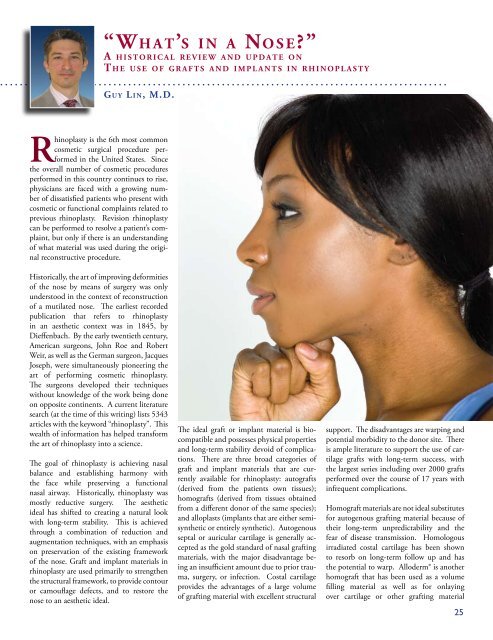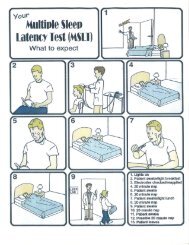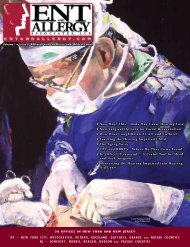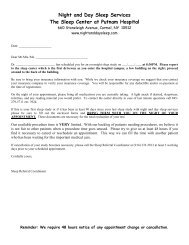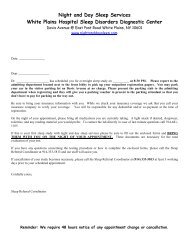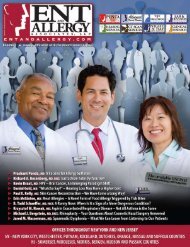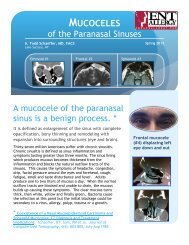A Royal Pain in the Throat Tinnitus - ENT & Allergy Associates
A Royal Pain in the Throat Tinnitus - ENT & Allergy Associates
A Royal Pain in the Throat Tinnitus - ENT & Allergy Associates
- No tags were found...
Create successful ePaper yourself
Turn your PDF publications into a flip-book with our unique Google optimized e-Paper software.
“Wh a t ’s <strong>in</strong> a No s e ?”A h i s t o r i c a l r e v i e w a n d u p d a t e o nT h e u s e o f g r a f t s a n d i m p l a n t s i n rh i n o p l a s t yG u y Li n, M.D.Rh<strong>in</strong>oplasty is <strong>the</strong> 6th most commoncosmetic surgical procedure performed<strong>in</strong> <strong>the</strong> United States. S<strong>in</strong>ce<strong>the</strong> overall number of cosmetic proceduresperformed <strong>in</strong> this country cont<strong>in</strong>ues to rise,physicians are faced with a grow<strong>in</strong>g numberof dissatisfied patients who present withcosmetic or functional compla<strong>in</strong>ts related toprevious rh<strong>in</strong>oplasty. Revision rh<strong>in</strong>oplastycan be performed to resolve a patient’s compla<strong>in</strong>t,but only if <strong>the</strong>re is an understand<strong>in</strong>gof what material was used dur<strong>in</strong>g <strong>the</strong> orig<strong>in</strong>alreconstructive procedure.Historically, <strong>the</strong> art of improv<strong>in</strong>g deformitiesof <strong>the</strong> nose by means of surgery was onlyunderstood <strong>in</strong> <strong>the</strong> context of reconstructionof a mutilated nose. The earliest recordedpublication that refers to rh<strong>in</strong>oplasty<strong>in</strong> an aes<strong>the</strong>tic context was <strong>in</strong> 1845, byDieffenbach. By <strong>the</strong> early twentieth century,American surgeons, John Roe and RobertWeir, as well as <strong>the</strong> German surgeon, JacquesJoseph, were simultaneously pioneer<strong>in</strong>g <strong>the</strong>art of perform<strong>in</strong>g cosmetic rh<strong>in</strong>oplasty.The surgeons developed <strong>the</strong>ir techniqueswithout knowledge of <strong>the</strong> work be<strong>in</strong>g doneon opposite cont<strong>in</strong>ents. A current literaturesearch (at <strong>the</strong> time of this writ<strong>in</strong>g) lists 5343articles with <strong>the</strong> keyword “rh<strong>in</strong>oplasty”. Thiswealth of <strong>in</strong>formation has helped transform<strong>the</strong> art of rh<strong>in</strong>oplasty <strong>in</strong>to a science.The goal of rh<strong>in</strong>oplasty is achiev<strong>in</strong>g nasalbalance and establish<strong>in</strong>g harmony with<strong>the</strong> face while preserv<strong>in</strong>g a functionalnasal airway. Historically, rh<strong>in</strong>oplasty wasmostly reductive surgery. The aes<strong>the</strong>ticideal has shifted to creat<strong>in</strong>g a natural lookwith long-term stability. This is achievedthrough a comb<strong>in</strong>ation of reduction andaugmentation techniques, with an emphasison preservation of <strong>the</strong> exist<strong>in</strong>g frameworkof <strong>the</strong> nose. Graft and implant materials <strong>in</strong>rh<strong>in</strong>oplasty are used primarily to streng<strong>the</strong>n<strong>the</strong> structural framework, to provide contouror camouflage defects, and to restore <strong>the</strong>nose to an aes<strong>the</strong>tic ideal.The ideal graft or implant material is biocompatibleand possesses physical propertiesand long-term stability devoid of complications.There are three broad categories ofgraft and implant materials that are currentlyavailable for rh<strong>in</strong>oplasty: autografts(derived from <strong>the</strong> patients own tissues);homografts (derived from tissues obta<strong>in</strong>edfrom a different donor of <strong>the</strong> same species);and alloplasts (implants that are ei<strong>the</strong>r semisyn<strong>the</strong>ticor entirely syn<strong>the</strong>tic). Autogenousseptal or auricular cartilage is generally acceptedas <strong>the</strong> gold standard of nasal graft<strong>in</strong>gmaterials, with <strong>the</strong> major disadvantage be<strong>in</strong>gan <strong>in</strong>sufficient amount due to prior trauma,surgery, or <strong>in</strong>fection. Costal cartilageprovides <strong>the</strong> advantages of a large volumeof graft<strong>in</strong>g material with excellent structuralsupport. The disadvantages are warp<strong>in</strong>g andpotential morbidity to <strong>the</strong> donor site. Thereis ample literature to support <strong>the</strong> use of cartilagegrafts with long-term success, with<strong>the</strong> largest series <strong>in</strong>clud<strong>in</strong>g over 2000 graftsperformed over <strong>the</strong> course of 17 years with<strong>in</strong>frequent complications.Homograft materials are not ideal substitutesfor autogenous graft<strong>in</strong>g material because of<strong>the</strong>ir long-term unpredictability and <strong>the</strong>fear of disease transmission. Homologousirradiated costal cartilage has been shownto resorb on long-term follow up and has<strong>the</strong> potential to warp. Alloderm® is ano<strong>the</strong>rhomograft that has been used as a volumefill<strong>in</strong>g material as well as for onlay<strong>in</strong>gover cartilage or o<strong>the</strong>r graft<strong>in</strong>g material25


